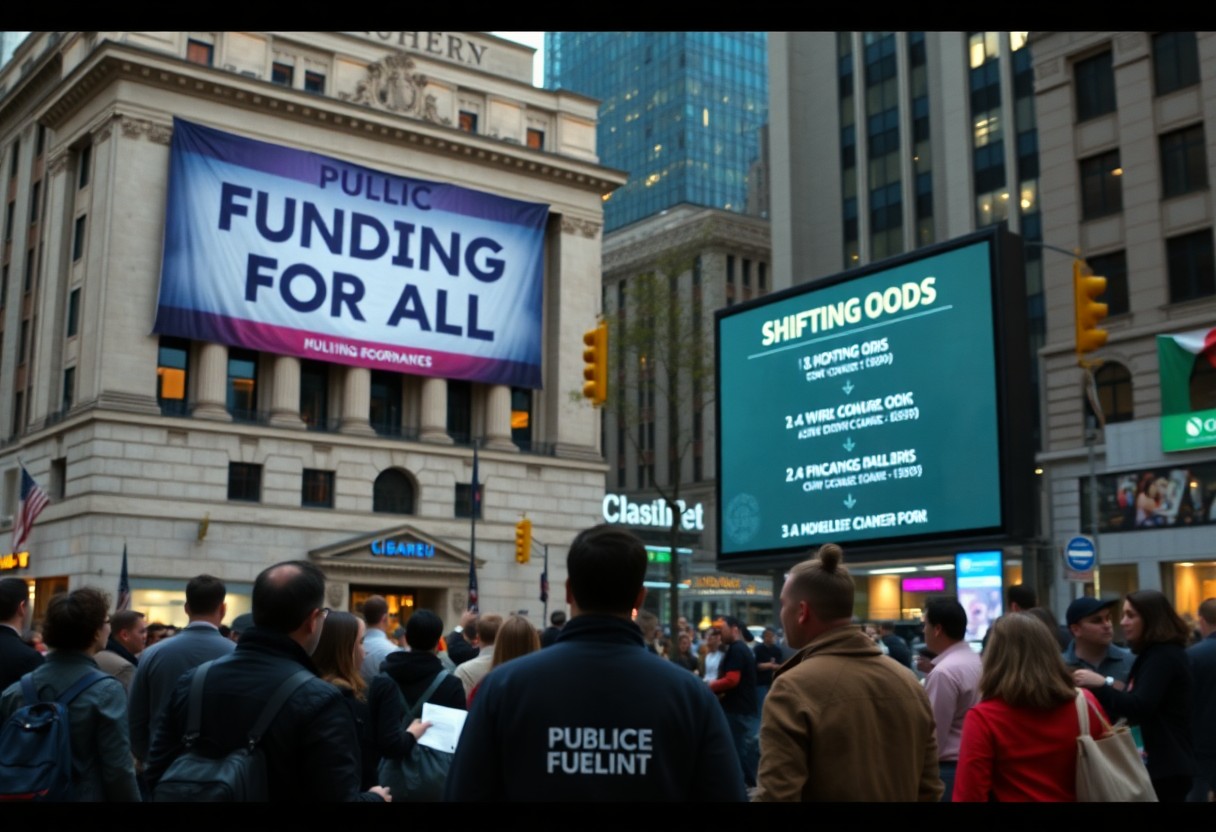Over time, public money can significantly shift odds in various markets, influencing the perception of risk and potential outcomes. As you navigate these waters, it’s imperative to understand how public sentiment and funding impact your decisions. Being aware of these dynamics allows you to capitalize on opportunities while avoiding potential pitfalls. In this post, we will explore the mechanisms behind public money’s influence and equip you with strategies to adapt your approach effectively.
Key Takeaways:
- Public funding can create imbalances in competition by favoring certain sectors or projects, leading to a distortion of market dynamics.
- To mitigate the effects of public money on competition, stakeholders should advocate for transparent allocation processes and establish guidelines that ensure fair distribution of resources.
- Engaging in public dialogue and fostering collaboration among different sectors can help create a more equitable environment that benefits all parties involved.
The Mechanics of Public Funding in Market Dynamics
Understanding how public funding operates requires a look at its intricacies within market dynamics. Government financial support can take various forms, such as grants, loans, and tax incentives, all of which allow for significant manipulation of market conditions. These financial tools alter competitive landscapes by shifting resources toward favored sectors, thus affecting pricing, innovation, and consumer choices. By injecting capital into select industries, you witness a ripple effect that changes the risk and reward balance for businesses and investors alike.
How Government Investment Alters Risk and Reward
Government investment serves to lower risk for certain industries while heightening it for others. By providing safety nets such as guaranteed loans or direct funding, you encourage investment into high-risk ventures, like renewable energy. Sectors that receive these financial boosts typically see reduced market volatility, as the infusion of public money stabilizes operations. In your portfolio, this creates opportunities: investing in sectors favored by government initiatives can lead to outsized returns compared to those that are less prioritized.
The Role of Subsidies in Shaping Industry Landscapes
Subsidies play a pivotal role in determining which industries thrive and which struggle. Targeted financial support can lead to significant competitive advantages, influencing everything from production costs to market entry barriers. For instance, the renewable energy sector has benefitted immensely from government subsidies, helping it expand rapidly while simultaneously stifling fossil fuel investments. You may find that your strategies must adapt based on these shifting landscapes, recognizing the sectors that are currently propped up by public funding.
Take, for example, the U.S. agricultural sector, which has received billions in subsidies over the years. These funds enable farmers to invest in advanced technology and sustainable practices that would otherwise be cost-prohibitive. Consequently, this financial backing supports not only the agricultural economy but also sets standards for production that smaller, unsubsidized farms struggle to meet. As you consider your investments, acknowledging the influence of subsidies can help you identify favorable market conditions and potential growth areas that align with government objectives.
The Consequences of Public Money Allocation
The allocation of public money can create a ripple effect throughout the economy, with broad-reaching consequences. Funding priorities often determine which sectors thrive while others struggle. For instance, investments in infrastructure can stimulate local job creation, but neglecting certain communities may exacerbate existing disparities, leading to frustration and social unrest. Understanding these consequences helps to elucidate the complex relationship between government spending and market outcomes.
Winners and Losers: Who Stands to Gain?
Your analysis of public money allocation reveals clear winners and losers. Typically, beneficiaries like large corporations or specific industries gain significant advantages through grants and tax incentives. Conversely, smaller firms and marginalized communities may find themselves further disadvantaged. As public funds channel resources toward certain sectors, economic landscapes evolve, often favoring those already in positions of power.
Long-term Impacts on Economic Inequality
Consistent trends in public funding can entrench economic inequality over time, favoring the affluent and leaving disadvantaged groups without opportunities. Policymaking that prioritizes wealthier neighborhoods for infrastructure investments ultimately widens the gap between rich and poor communities. Consequently, the systemic bias in funding allocation lays the groundwork for entrenched disparities.
The implications of inequitable public funding extend far beyond immediate financial outcomes. For example, in 2020, a study found that neighborhoods receiving inadequate investment saw a rise in unemployment rates by over 15% compared to those benefitting from funding boosts. This lack of access to resources not only limits economic mobility but also perpetuates cycles of poverty. When educational institutions in underfunded areas lack adequate support, the result is a workforce ill-prepared for the demands of a competitive job market, ultimately stifling innovation and growth potential across the entire economy. These long-term impacts illustrate the necessity of advocating for more equitable distribution of public funds, ensuring that all communities can thrive.
Strategies for Navigating Public Funding Landscapes
Successfully navigating the complex terrain of public funding requires strategic foresight and adaptability. By recognizing where public investments are being directed and aligning your business objectives with these initiatives, you can position yourself to leverage upcoming opportunities. This involves actively monitoring government budgets, engaging in community discussions, and developing relationships with local leaders to anticipate funding changes that could impact your sector or organization.
Positioning Your Business to Benefit from Public Investments
Your ability to benefit from public investments hinges on how well you align your business strategies with areas of public interest. Tailoring your proposals to meet government objectives—such as sustainability, job creation, or community support—can enhance your chances of receiving funding. Regularly participating in local networking events and workshops can help you stay informed about what aligns with public funding priorities, thus improving your positioning.
Identifying Opportunities for Collaboration with Government Entities
Identifying collaboration opportunities with government entities allows you to tap into public resources and broaden your operational horizons. Look for programs that encourage public-private partnerships, such as economic development initiatives targeted at specific industries. Attending government meetings and engaging with programs that focus on innovation can unveil numerous avenues for collaboration that align with your business goals.
Exploring specific government initiatives, such as innovation grants, business incubators, or regional development projects, can reveal hidden opportunities for your organization. For example, many cities have launched public-private partnerships to modernize infrastructure or enhance local services, offering businesses like yours a chance to collaborate on projects that directly benefit both parties. Taking the initiative to engage with these programs often means not only accessing valuable funding but also expanding your network and influence within the community. Keep your ear to the ground for calls for proposals or partner invitations, and ensure your business is ready to respond promptly.
Rethinking Accountability: Who Monitors Public Cash Flow?
In an environment where public funds heavily influence market conditions, the method of monitoring these financial disbursements warrants serious re-evaluation. Traditional oversight mechanisms often falter under the weight of bureaucracy and political influences. By shifting the lens on who can effectively oversee public expenditures, you can uncover better strategies for maintaining accountability and addressing misuse. Identifying strengths and weaknesses in current monitoring systems will empower you to push for more effective oversight that truly reflects the interests of the public.
The Importance of Transparent and Responsible Funding Use
When taxpayer dollars are at play, transparent and responsible use is non-negotiable. You must ensure that public funding is allocated effectively, giving the public assurance that their money is contributing to societal well-being rather than inflated bureaucratic processes. Establishing checks and balances in funding dispersals not only mitigates the risks of corruption but also reinforces trust within communities and enhances public participation in future funding decisions.
New Models of Oversight in Government Financial Disbursements
The landscape of government financial oversight is rapidly evolving, pivoting towards innovative models that optimize both accountability and efficiency. Engaging technology to leverage real-time data can significantly enhance monitoring capabilities. Engaging community watchdogs and utilizing crowdsourced funding audits allows for grassroots transparency, ensuring that those utilizing funded projects genuinely reflect the needs of your community. These progressive models help establish a spirit of collaboration between governmental entities and the public, fostering greater trust and involvement in the oversight process.
One prominent example of this new model is the introduction of blockchain technology in public funding tracking. This decentralized method records transactions in a way that is both transparent and immutable, allowing anyone to verify the flow of funds without the interference of traditional oversight mechanisms. Additionally, participatory budgeting initiatives are gaining traction, where community members directly influence how funds are distributed. These models not only enhance accountability but also actively engage you, the citizen, in the financial decision-making process, ensuring your voice is heard and valued.
Lessons from the Frontlines: Voices of Experience
In the world of public funding, real-life insights from industry veterans can illuminate paths you might not have considered. Engaging with those who have successfully navigated funding landscapes offers you invaluable perspectives, revealing tactics and strategies that can fortify your approach. These voices share commonalities—resiliency, adaptation, and the willingness to innovate, reinforcing that learning from past undertakings is vital in harnessing public money effectively.
Testimonials from Industry Leaders on Leveraging Public Funds
Industry leaders emphasize the importance of aligning your mission with the priorities of public funding agencies. They highlight the significance of demonstrating tangible outcomes and return on investment, as funding bodies favor initiatives that provide measurable benefits to the community. One CEO noted their organization secured funding by showcasing a clear alignment with local government goals, thus amplifying the project’s credibility.
Key Takeaways from Successful Funding Initiatives
Successful funding initiatives often hinge on strategic storytelling and data-driven proposals. First, engage stakeholders early to build partnerships and gather insights. Next, demonstrate clear community impact, showing how your project addresses pressing issues. Lastly, establish a feedback loop to continuously assess and refine your approach, ensuring sustainable funding and support over time.
Examining case studies, initiatives like the Green City Project reveal that those who prioritized collaboration saw a 40% increase in funding secured. By pinpointing local priorities and engaging in dialogue with community members, leaders were able to craft persuasive narratives that resonated with decision-makers. Utilizing metrics to validate results not only enhances credibility but also builds trust, making future funding easier to acquire. Incorporate these strategies into your funding approach to significantly shift the odds in your favor.
To wrap up
To wrap up, understanding how public money impacts various sectors can significantly influence your strategies for advocacy, investment, and community engagement. By recognizing the dynamics of funding and its effects on opportunities, you can better position yourself to engage with policymakers and stakeholders. Utilize data-driven strategies to advocate for equitable funding, ensuring that public resources serve the broader community effectively. Staying informed and proactive allows you to harness public finances in ways that align with your goals and values, ultimately fostering a more balanced and inclusive system.
FAQ
Q: How does public money influence betting odds in sports?
A: Public money impacts betting odds as bookmakers adjust lines to balance their risk based on the amount of money wagered on both sides of a bet. When a significant amount of public money is placed on a particular team or outcome, sportsbooks may shift the odds to attract more bets on the opposing side. This helps them manage their potential losses and ensures a more even distribution of bets, allowing them to make a profit regardless of the event’s outcome.
Q: What strategies can bettors use to leverage shifts in odds caused by public money?
A: Bettors can take advantage of shifts in odds by closely monitoring line movements and understanding the patterns created by public betting behavior. One effective strategy is to bet early when the odds are first released before the public money starts to influence the lines. Alternatively, bettors might wait for significant line shifts to find potentially valuable betting opportunities, particularly if they believe the public is overvaluing a certain team. Additionally, conducting thorough research beyond public betting trends can help identify underdog bets that are undervalued.
Q: Are there specific sports or events where public money has a more pronounced effect on odds?
A: Public money tends to have a more significant impact on high-profile sports events, such as the Super Bowl, the World Series, or major soccer tournaments. In these cases, the volume of bets placed by casual viewers can heavily influence odds. Additionally, sports leagues with a large fan base and significant media coverage, like the NFL or NBA, often see lines shift more drastically due to public perception and betting preferences. Bettors may want to approach these high-stakes games with caution, as public sentiment can sometimes lead to inflated odds for certain teams.




